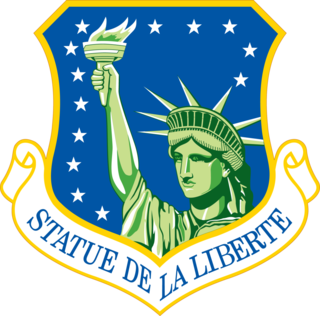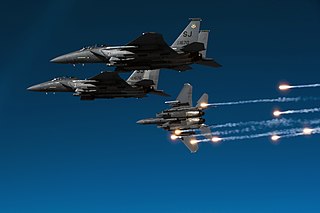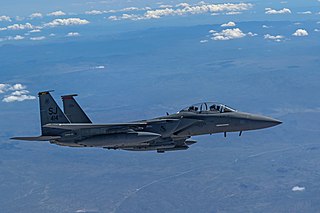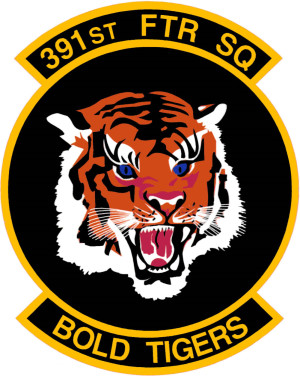
The 48th Fighter Wing is part of the United States Air Force's Third Air Force, assigned to Headquarters Air Command Europe and United States Air Forces in Europe (USAFE). It is based at RAF Lakenheath, England. The 48 FW is the only F-15 wing based in Europe which hosts two F-15E Strike Eagle squadrons. The wing also hosts two F-35A Lightning II squadrons. The 48 FW was given the name "Statue of Liberty Wing" on 4 July 1954 and remains the only U.S. Air Force unit with both a name and a numerical designation.

The 335th Fighter Squadron is a United States Air Force unit. It is assigned to the 4th Operations Group and stationed at Seymour Johnson Air Force Base, North Carolina.

The 334th Fighter Squadron is a United States Air Force unit. It is assigned to the 4th Operations Group and stationed at Seymour Johnson Air Force Base, North Carolina.

The 182d Fighter Squadron is a unit of the Texas Air National Guard 149th Fighter Wing located at Kelly Field Annex, Joint Base San Antonio, Texas. The 149th is equipped with the F-16C/D Fighting Falcon.

The 4th Operations Group is the flying component of the 4th Fighter Wing, assigned to the United States Air Force Air Combat Command. The group is stationed at Seymour Johnson Air Force Base, North Carolina.

The 479th Flying Training Group is a United States Air Force unit, stationed at Naval Air Station Pensacola. A component of Air Education and Training Command, the group was activated on 2 October 2009. The current commander of the 479th Flying Training Group is Colonel Shane “Shamus” Muscato.

The 181st Airlift Squadron is a unit of the 136th Airlift Wing of the Texas Air National Guard stationed at Naval Air Station Joint Reserve Base Fort Worth, Texas. The 181st is equipped with the Lockheed C-130J Hercules.

The 55th Fighter Squadron is part of the 20th Fighter Wing at Shaw Air Force Base, South Carolina. It operates the General Dynamics F-16 Fighting Falcon aircraft conducting air superiority missions.

The 307th Fighter Squadron is a McDonnell Douglas F-15E Strike Eagle unit and is part of Air Force Reserve Command's 414th Fighter Group stationed at Seymour Johnson Air Force Base, North Carolina.

The 391st Fighter Squadron is part of the 366th Fighter Wing at Mountain Home Air Force Base, Idaho. The squadron participated in combat missions in World War II and the Vietnam War, provided air defense in Korea and Japan from 1968 to 1971, and continues to provide tactical air command for the United States Air Force. It currently operates McDonnell Douglas F-15E Strike Eagle aircraft, conducting close air support missions.

The 492d Fighter Squadron, nicknamed "the Madhatters", is part of the 48th Fighter Wing at RAF Lakenheath, England, where they operate the McDonnell Douglas F-15E Strike Eagle.

The 494th Fighter Squadron, nicknamed the Panthers, is part of the 48th Fighter Wing at RAF Lakenheath, United Kingdom, where they operate the McDonnell Douglas F-15E Strike Eagle.

The 510th Fighter Squadron is part of the 31st Operations Group at Aviano Air Base, Italy. It is a combat-ready F-16CM fighter squadron prepared to deploy and fly combat sorties as tasked by NATO and US combatant commanders.

The 550th Fighter Squadron is an active United States Air Force unit. Its current assignment is with 56th Operations Group, at Kingsley Field, Oregon.

The 461st Flight Test Squadron is a United States Air Force squadron, assigned to the 412th Operations Group of Air Force Materiel Command, and is stationed at Edwards Air Force Base, California. The Squadron performs flight testing on the Lockheed Martin F-35 Lightning II.

The 401st Air Expeditionary Group is a provisional United States Air Force unit assigned to United States Air Forces in Europe to be activated or inactivated at any time as needed. It is stationed at Ramstein Air Base, Germany.

The 48th Operations Group is the flying component of the 48th Fighter Wing, assigned to the United States Air Forces in Europe – Air Forces Africa. The group is stationed at RAF Lakenheath, England.

The 481st Tactical Fighter Training Squadron is an inactive United States Air Force fighter squadron. Its last assignment was with the 27th Tactical Fighter Wing at Cannon Air Force Base, New Mexico, where it was inactivated on 8 July 1980.

The 172nd Attack Squadron is a unit of the Michigan Air National Guard 110th Wing located at Battle Creek Air National Guard Base, Battle Creek, Michigan. The 172nd is equipped with the MQ-9 Reaper drone.

The 4th Fighter Wing is a United States Air Force unit assigned to the Air Combat Command's Ninth Air Force. It is stationed at Seymour Johnson Air Force Base, North Carolina, where it is also the host unit.







































